Mammals of the Adirondacks:
Woodchuck (Marmota monax)
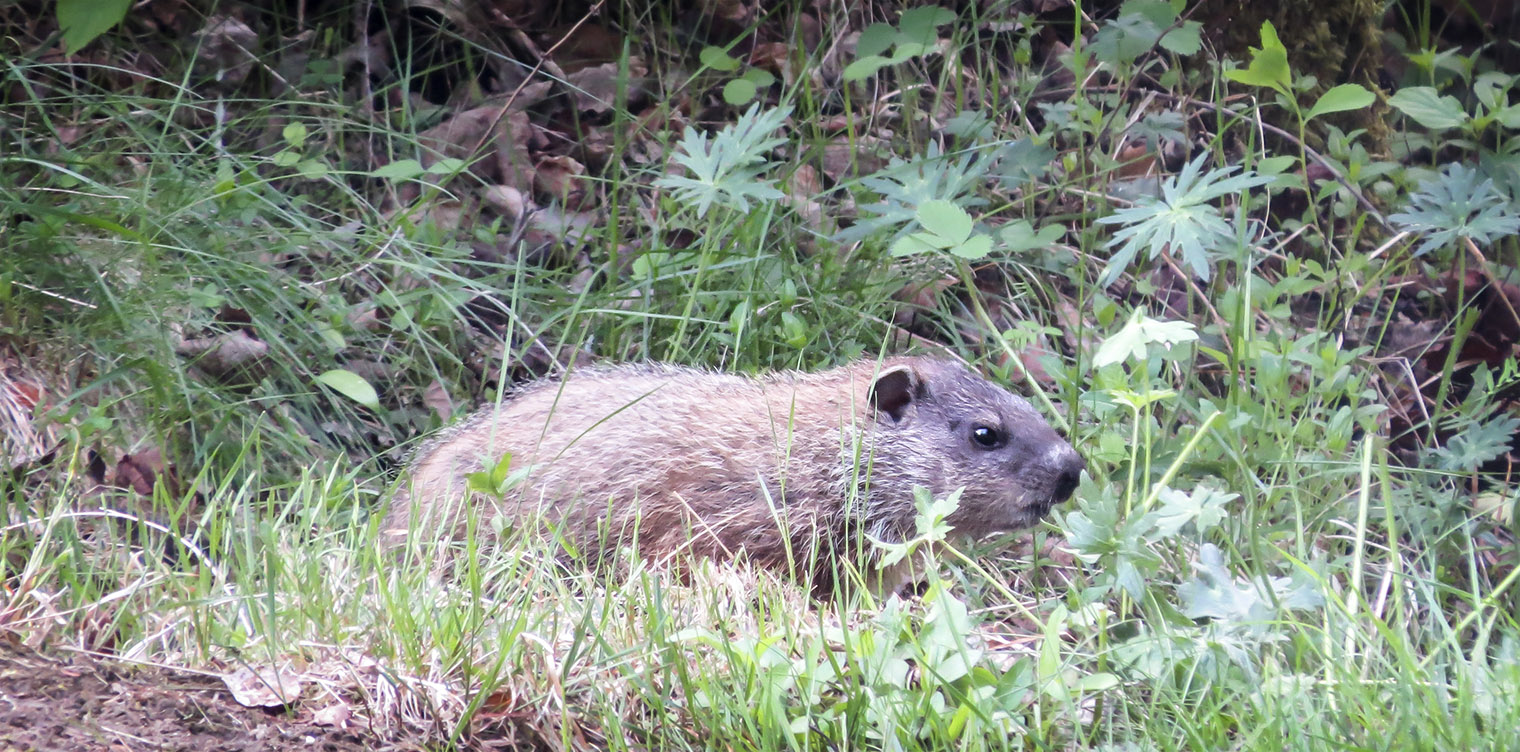
Woodchucks (Marmota monax) are large burrowing rodents with grizzled brown fur. They are most abundant on the Adirondack Park's periphery. These herbivores use wooded areas for hibernation and fields for breeding and foraging.
Woodchucks, like American Beaver and North American Porcupine), are assigned to the rodent (Rodentia) family, the single largest group of mammals. The Woodchuck is the largest member of the squirrel family (Sciuridae) in the Adirondacks. Other members of this family include Eastern Chipmunks, Gray Squirrels, and Red Squirrels.
The Woodchuck, which is part of the Marmota genus, is one of six species of marmot which occur in North America.
- Nine subspecies of Marmota monax are recognized. The subspecies found in the Adirondack region is Marmota monax rufescens.
- The species name (monax) means solitary, which is a reference to the Woodchuck's social system.
- The Woodchuck was once referred to as Arctomys monax.
The nonscientific name "Woodchuck" is said to be derived from the Native American name "wuchak," which means "the digger." Other nonscientific names include Groundhog and Whistle Pig. The latter name is a reference to the vocalization Woodchucks use when alarmed.
The Woodchuck is the star player in Groundhog Day – a popular tradition celebrated in Canada and the United States every year on 2 February.
- The celebration of Groundhog Day, which first occurred in German communities in Pennsylvania, is based on a legend that spring will arrive early if the Groundhog does not see his shadow.
- The best-publicized Groundhog Day celebration is held in the western Pennsylvania municipality of Punxsutawney, where a Woodchuck named Punxsutawney Phil is the main attraction in a ceremony often attended by over 20,000 fans.
Woodchuck: Description
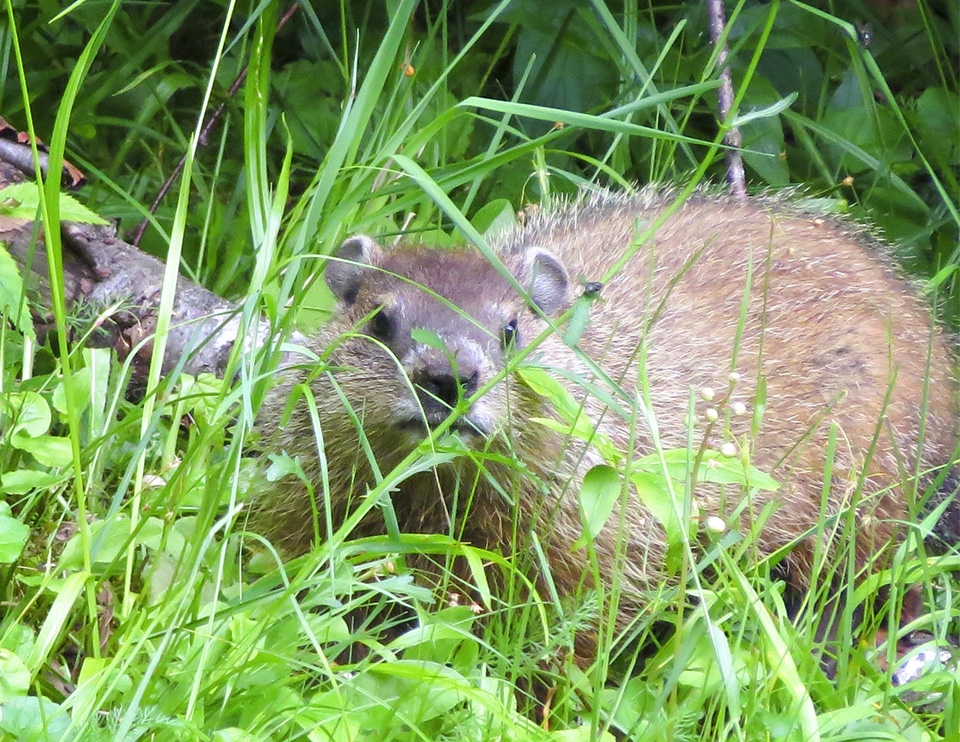
Woodchucks look like large, furry potatoes with stubby legs. Their body is compact and stocky in appearance. The tail is relatively short, comprising about a quarter of the animal's total length. The legs are short and thick. The head is broad, short, and flat. Woodchucks have short, rounded ears on the top of their heads.
Woodchucks gain weight during the summer, putting on fat equaling about a third of their weight. They lose weight during hibernation in the winter, when they draw on the fat stored during the summer. These variations may account to some degree for the fact that sources are not in agreement on Woodchuck measurements and weight.
- Armitage's chapter on marmots in Wild Mammals of North America (2003) provides data on Woodchucks, listing a total length of 20-27 inches (including the tail) and a mean body mass of 7.8 pounds in the spring just after the animals had emerged from hibernation and 10 pounds in the fall.
- W. J. Hamilton's 1934 study, based on Woodchucks taken in central New York State, reported an average length of 22.2 inches. Like other researchers, Hamilton found that weight varied with the season. Woodchucks killed in the late summer and fall were considerably heavier (8-10 pounds) than those killed in spring who had just emerged from hibernation (4-5 pounds). The average weight of 326 adults collected from late March to late September was a bit over six pounds, with males slightly heavier than females.
Woodchucks have brown to blackish-brown woolly underfur on their backs and sides. Their body is covered with guard hairs with white, buffy yellow or cinnamon brown tips, producing a frosted or grizzled appearance. The subspecies found in the Adirondack region (Marmota monax rufescens) is redder than the other subspecies, with pinkish cinnamon and orange-cinnamon shading. The feet are dark brown or black.
Woodchuck: Diet
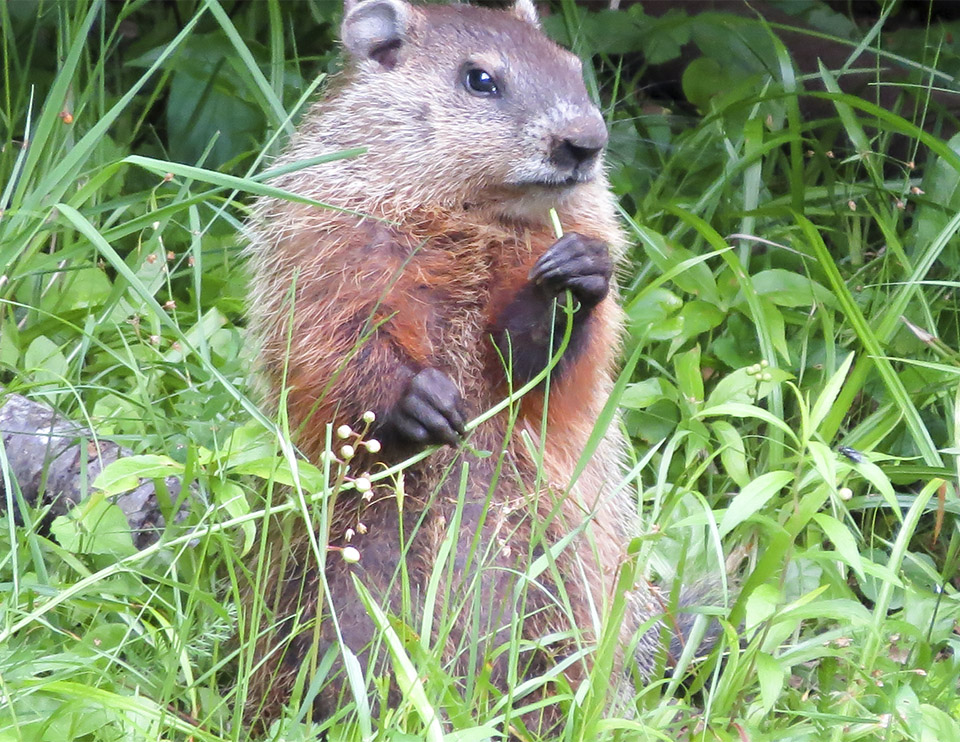
Woodchucks, like other marmot species, are herbivores. The bulk of their diet consists of herbaceous plants. Primarily a grazer, the Woodchuck eats the vegetative parts of plants, but will also consume the bark and twigs if no green leaves are available. Woodchucks can consume up to 1½ pounds of vegetation per day; vegetation is their major source of water. The Woodchuck's preferred menu includes clovers (an estimated 10-25% of their diet), grasses (5-10%), dandelions, and goldenrods. Woodchucks are generalists and easily switch food choices depending on local availability.
Woodchucks also consume a variety of cultivated crops such as grains, alfalfa, hay grasses, and vegetables. In the Adirondacks, Red Clover (Trifolium pratense) is reportedly a favorite food in all seasons. Woodchucks also eat berries and the buds of some deciduous shrubs. Apples, if available, form an important part of their diet in late summer and fall.
Woodchucks may consume some insects, such as June bugs and grasshoppers. However, animal foods reportedly make up less than one percent of their diet.
Woodchuck foraging patterns depend on the season. During the summer, they tend to forage early in the morning and late in the afternoon. In the spring and fall, they are more apt to be found foraging in the middle of the day. Foraging bouts are said to last less than two hours.
Woodchuck: Reproduction and Family Life
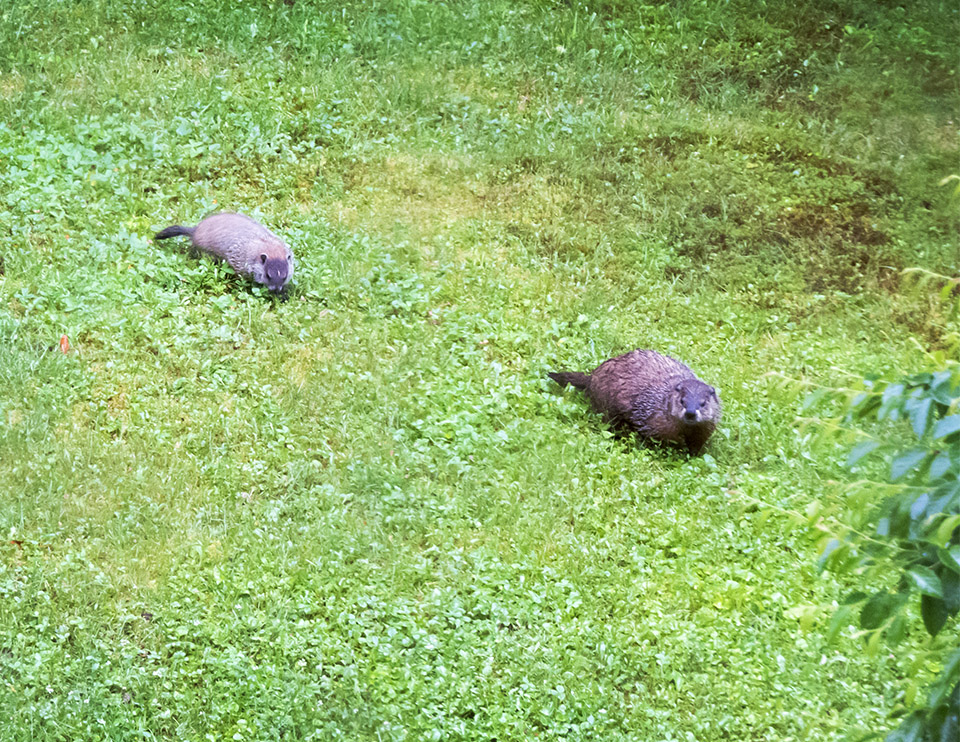
Woodchucks breed in the spring, soon after they emerge from hibernation. Males emerge from hibernation first to establish territories and start searching for a female. Male woodchucks mate with one or more females, while female Woodchucks are said to mate with only one male. Some Female Woodchucks reportedly breed as yearlings, but they are said to have a lower pregnancy rate than older females.
The timing of breeding depends on latitude and local conditions.
- In the Adirondacks, mating apparently occurs in the middle or latter part of March.
- Woodchuck pups (generally four to six offspring) are born in an underground nest after a gestation period of 31 to 33 days, usually in late April or early May in our region.
All parental care is provided by the female. The young Woodchucks begin to leave the den after about a month, spending time outside the burrow, but returning to it for protection when the mother is away. Weaning reportedly occurs at five or six weeks of age. Young woodchucks disperse in July and early August. Some dig temporary dens near the burrow where they were born, then later establish a home range in unoccupied territory.
Woodchuck: Behavior
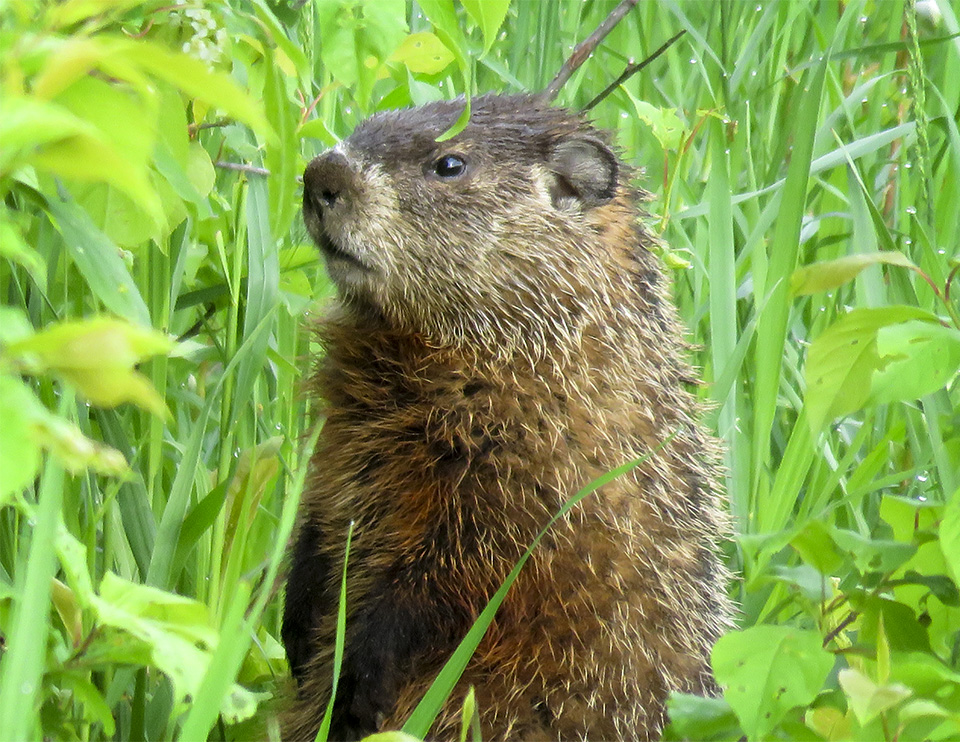
Woodchucks, like all species of marmots, have adapted to the seasonal lack of food by hibernating. Most North American marmots hibernate for about seven to eight months. The Woodchuck, however, hibernates only for about 5 or 5½ months. Winter burrows reportedly are often located in the woods, in contrast to summer burrows, which are usually located in nearby open areas, closer to their food supply.
The timing and duration of hibernation depend on latitude and gender. Woodchucks in northern regions hibernate longer than their counterparts in the south. In the Adirondack region, Woodchucks generally begin hibernating in late September or early October. To conserve energy, the heart rate of hibernating Woodchucks declines from the normal rate of 80-100 beats per minute to 4 or 5 beats per minute when the animal is in deep hibernation. Body temperature and oxygen consumption also decrease.
Emergence from the den is correlated with periods of warm weather. In the Adirondacks, Woodchucks normally emerge from hibernation in the middle and latter part of March. Male Woodchucks emerge from their winter dens earlier than females; as a result, their hibernation period is significantly shorter (an estimated 105 days).
After emerging from hibernation, Woodchucks spend much of their time in or near their burrows, which is excavated using their strong claws and legs. The Woodchuck's summer den usually has several entrances and many chambers and tunnels. The main entrance is often marked with a mound of dirt. Woodchucks may have several burrows.
Woodchucks are mainly diurnal.
- In midsummer, they are most active early in the morning and late in the afternoon.
- In early spring and late summer, they tend to be most active in the middle of the day.
- Outside of their burrow, they spend most of their time feeding or sunning themselves near the burrow entrance, often standing upright to survey their surroundings. If alarmed, the Woodchuck may give a sharp whistle-like sound (hence the name Whistle Pig) before it ducks back into its burrow.
In contrast to other North American Marmots, Woodchucks are solitary and nonsocial. In early spring, the adult female and her yearling daughters may share the same burrow, but this arrangement ends after the older female gives birth to a new litter. Adults usually avoid each other. Woodchucks are territorial; the size of their home ranges varies with locality.
Woodchuck: Mortality and Predators
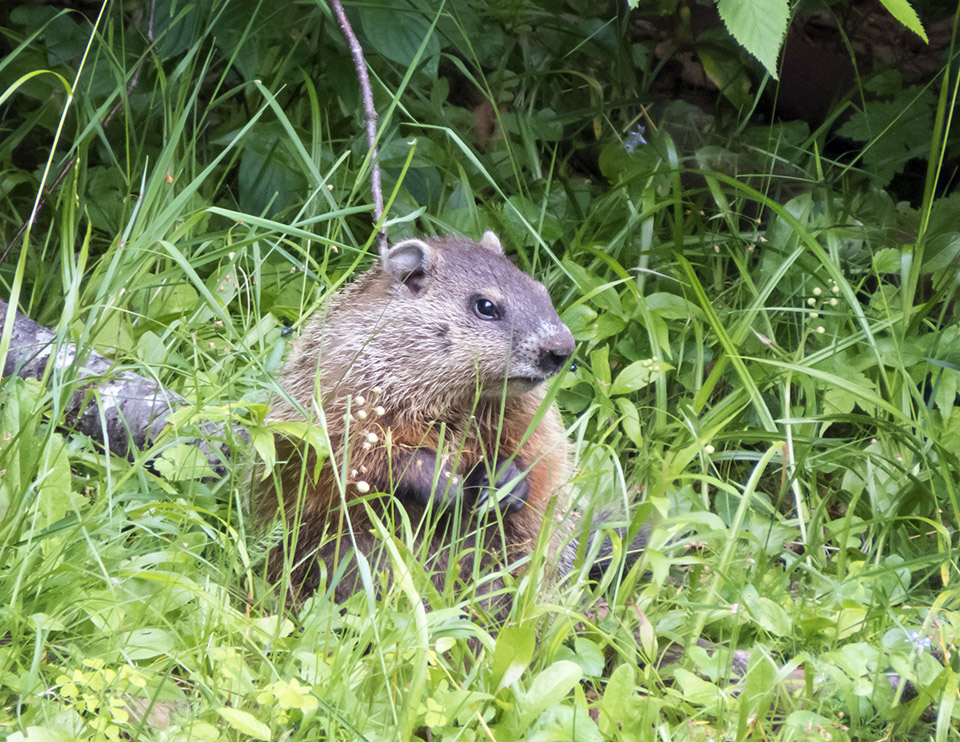
The Woodchuck has a host of predators, which helps explain why this mammal (which may live up to ten years in captivity) often does not live past the age if three in the wild.
Human predators probably exact the greatest toll on Woodchucks. Woodchucks tend to be unpopular with farmers, because they destroy crops, and the mounds around their burrows have been known to injure livestock and damage farm equipment. In New York State, the Woodchuck is one of the few unprotected species of wildlife. (Other unprotected species include Red Squirrels and North American Porcupines.) Although a hunting license is required to hunt Woodchucks, they may be killed at any time without any limit. Other Woodchucks, attracted to the vegetation along grassy roadsides, die on roadways.
The Red Fox is said to be the Woodchuck's deadliest natural predator. Red Foxes reportedly target young Woodchucks, carrying them back to their own dens to feed to their young. Other known predators include Eastern Coyotes, Gray Foxes, American Black Bears, Bobcats, hawks, and snakes.
Woodchucks avoid predation by climbing trees and retreating to their dens when threatened. They also can use their teeth to defend themselves.
Woodchuck: Distribution
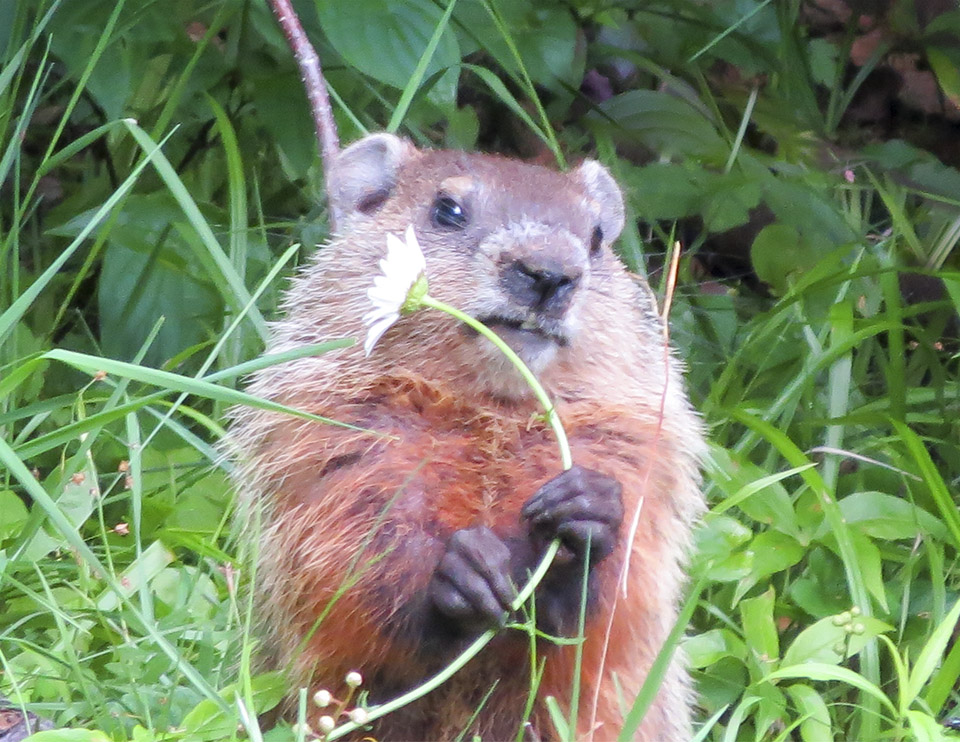
Prior to colonization, when much of eastern North America was covered with dense forests, Woodchucks are said to have been relatively rare, living mainly along the edges of woods. As land was cleared, the open fields and edge habitats that Woodchucks favor increased, as did the number of Woodchucks.
The Woodchuck is currently the most wide-ranging of North America's marmots. It is found from central Alaska east through Canada to Labrador, and in eastern North America south to Georgia, Alabama, Louisiana, and Arkansas. In the west, the Woodchuck's range extends southward into the Rocky Mountains to northern Idaho. It is absent from prairie regions in western Canada and the US. The Woodchuck is the only marmot that occurs in the eastern half of the US.
In the Adirondacks, the Woodchuck occurs throughout the entire region. It is found in clearings, meadows, and roadsides to elevations of about 2500 feet. Woodchucks probably are most abundant on the periphery of the Adirondack Park, where much of the Park's remaining agricultural land is located. In the central Adirondacks, Woodchucks tend to be more common along roadsides and in villages.
Woodchuck Habitat
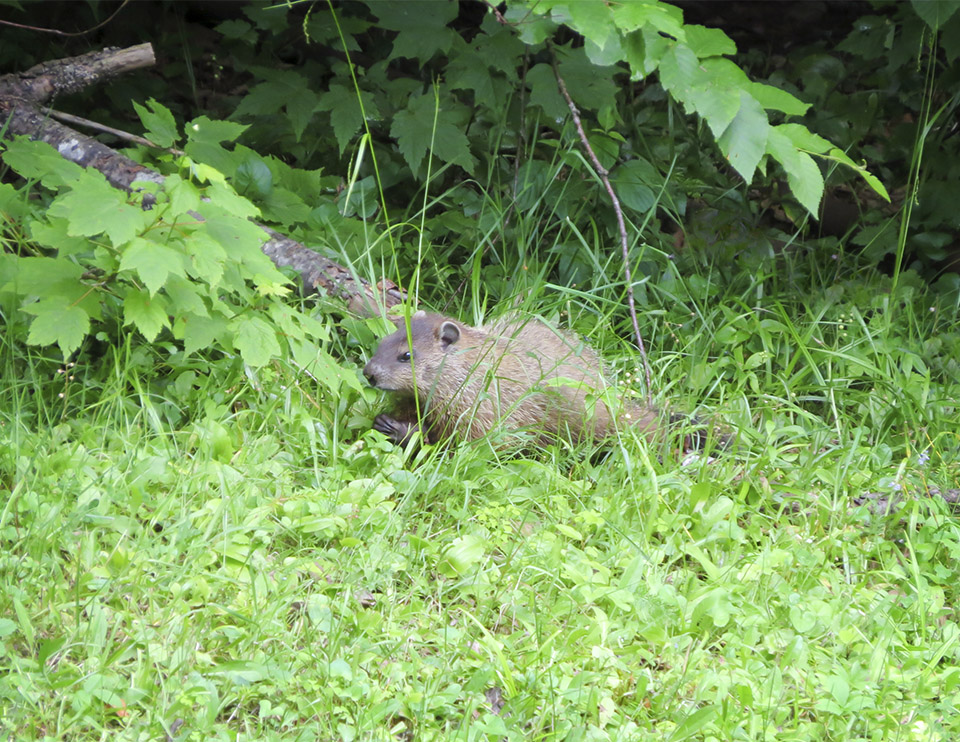
The Woodchuck's preferred habitat is the forest-edge.
- It prefers a combination of well-drained soils in which to burrow, open areas close to food sources (such as farmlands, meadows, orchards, and old fields) for breeding and foraging, and nearby wooded areas for hibernation.
- Woodchucks may be found near hedgerows, vegetated gullies, and hilly, rocky areas in open woodlands that have nearby fields or meadows.
- The Woodchuck is well-adapted to human-dominated landscapes and is often found in villages, highway roadsides, and utility corridors.
Where to See Woodchucks in the Adirondacks
In the Adirondacks, Woodchucks are most likely to be found along roadsides and utility corridors. Look for them along the edges of meadows, cleared agricultural land, golf course fairways, and old fields. Clues to the Woodchuck's presence include holes in the ground surrounded by mounds of fresh dirt. Among the trails covered here, the most likely places to spot a Woodchuck include the Old Orchard Loop and Big Field Loop at Heaven Hill.
Adirondack Mammal List
References
New York State Department of Environmental Conservation. Small Game Hunting. Retrieved 4 February 2019.
State University of New York. College of Environmental Science and Forestry. Woodchuck. Retrieved 30 January 2019.
Gary G. Kwiecinski, “Marmota monax,” Mammalian Species, Number 591 (4 December 1998), pp. 1-8. Retrieved 30 March 2017.
Integrated Taxonomic Information System On-line Database. Marmota monax. Retrieved 25 March 2021.
F. Cassola. Marmota monax. The IUCN Red List of Threatened Species 2016. Retrieved 25 March 2021.
University of Michigan. Animal Diversity Web. Woodchuck. Marmota monax. Retrieved 2 February 2019.
D. Andrew Saunders. Adirondack Mammals (Adirondack Wildlife Program. State University of New York. College of Environmental Science and Forestry, 1988 ), pp. 80-84.
William K. Chapman. Mammals of the Adirondacks. A Field Guide (North Country Books, 1991), pp. 53-55, Plate 12.
John O. Whitaker, Jr. and William J. Hamilton, Jr. Mammals of the Eastern United States (Cornell University Press, 1998), pp. 207-213.
William J. Hamilton and John O. Whitaker, Jr. Mammals of the Eastern United States. Second Edition (Cornell University Press, 1979), pp. 144-147. Retrieved 2 February 2019.
New York State. Department of Environmental Conservation. New York Natural Heritage Program. Ecological Communities of New York State. Second Edition (March 2014), pp. 96-97. Retrieved 17 October 2015.
iNaturalist. Adirondack Park Sightings. Woodchuck. Retrieved 25 March 2021.
Alexander C. Martin, Herbert S. Zim, and Arnold L. Nelson. American Wildlife & Plants. A Guide to Wildlife Food Habits (Dover Publications, 1951), pp. 21, 218, 229-230, 362-361, 402-403. Retrieved 22 January 2019.
James M. Ryan. Adirondack Wildlife. A Field Guide (University of New Hampshire Press, 2008), p. 197.
Donald W. Stokes and Lillian Q. Stokes. A Guide to Animal Tracking and Behavior (Little, Brown and Company, 1986), pp. 190-197.
William Henry Burt. A Field Guide to the Mammals of North America North of Mexico. Third Edition (Houghton Mifflin Company, 1980), pp. 92-93, Plate 9. Retrieved 2 February 2019.
Luigi Boitani and Stefania Bartoli. Simon & Schuster's Guide to Mammals (Simon & Schuster, 1982), p. 150. Retrieved 2 February 2019.
National Geographic Society. Wild Animals of North America (National Geographic Society, 1995), p. 110.
Adrian Forsyth. Mammals of North America. Temperate and Arctic Regions. (Firefly Books, 1999), pp. 95-96.
Richard M. DeGraaf and Mariko Yamasaki. New England Wildlife: Habitat, Natural History, and Distribution (University Press of New England, 2001), pp. 324, 418, 452. Retrieved 2 February 2019.
Kenneth B. Armitage, "Marmots: Marmota monax and Allies," in George A. Feldhamer, Bruce C. Thompson, and Joseph A. Chapman (Eds). Wild Mammals of North America: Biology, Management, and Conservation. Second Edition (The Johns Hopkins University Press, 2003) pp. 188-210.
Clinton Hart Merriam. The Vertebrates of the Adirondack Region, Northeastern New York (Press of L.S. Poster, 1882), pp. 28, 45. Retrieved 2 March 2017.
Clinton Hart Merriam. The Mammals of the Adirondack Region, Northeastern New York (Self-published, 1884), pp. 240-252. Retrieved 2 March 2017.
James E. Lloyd, "Vocalization in Marmota monax," Journal of Mammalogy, Volume 53, Number 1 (February 1972), pp. 214-216. Retrieved 1 February 2019.
Stam M. Zervanos, Christine R. Maher, Jerry A. Waldvogel and Gregory L. Florant, "Latitudinal Differences in the Hibernation Characteristics of Woodchucks (Marmota monax)," Physiological and Biochemical Zoology: Ecological and Evolutionary Approaches, Volume 83, Number 1 (January/February 2010), pp. 135-141. Retrieved 31 January 2019.
David E. Davis, " Role of Ambient Temperature in Emergence of Woodchucks (Marmota monax) from Hibernation," The American Midland Naturalist, Volume 97, Number 1 (January 1977), pp. 224-229. Retrieved 30 January 2019.
W. J. Hamilton. "The life history of the Rufescent Wood-chuck, Marmota monax rufescens Howell" Annals of the Carnegie Museum, Volume 23 (1934), pp. 85-178. Retrieved 1 February 2019.
Arthur H. Howell, "Revision of the American Marmots," North American Fauna, Number 37 (April 1915), pp. 1-80. Retrieved 4 February 2019.
